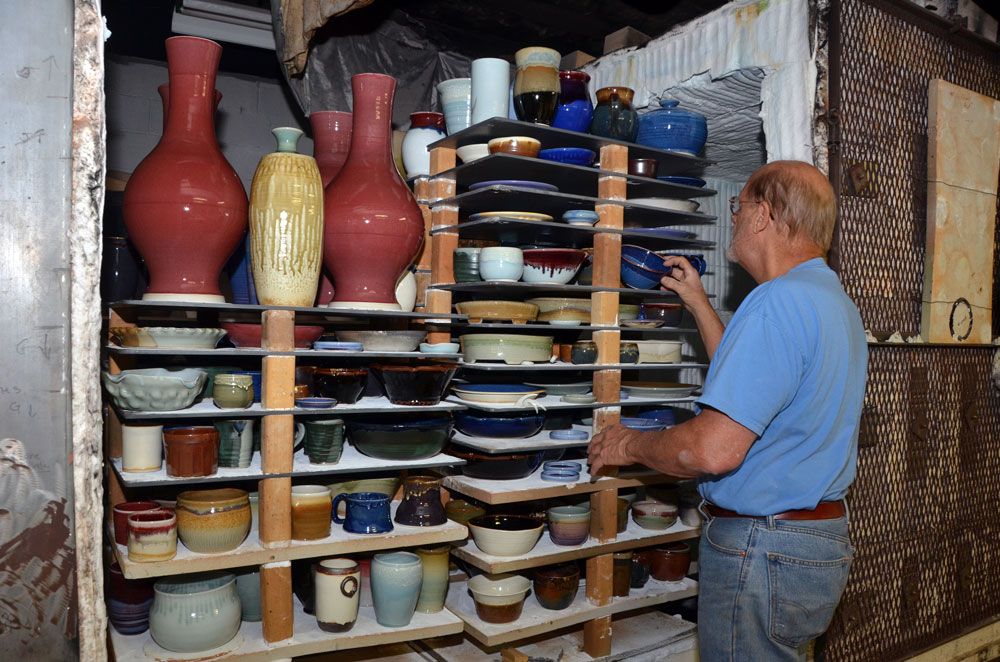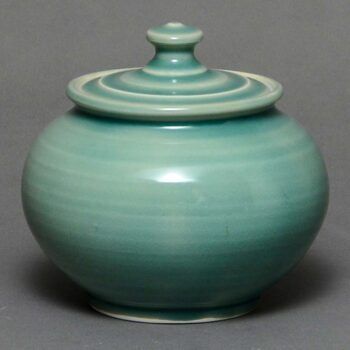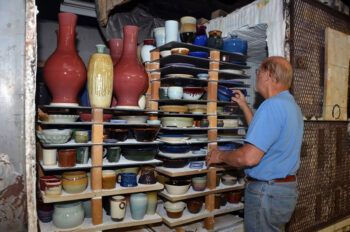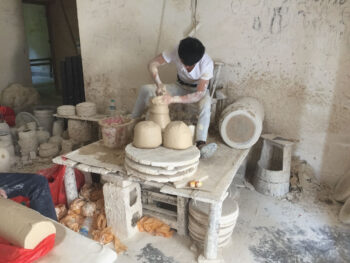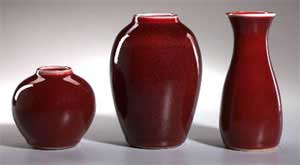What you need
This depends on what you want to make. I have been in some studios where there is not a wheel, just lots of tables for hand building. In any case you need space, that is heated, comfortable, well lighted, and pleasant, and lots of shelves and storage space and a sink. 100 sq. feet is really small. 300 or more adequate, 500 would be great. And if you plan on firing, this is not easily done in an apartment or home.
Consider visiting some studios and making a list of what you see that you will want. You can do a consultation at our studio if you like.
Making pottery involves more than just buying lots of “stuff”. You will also need knowledge that goes beyond simply throwing and forming. You will also need to know about glazes and firing. Those things will likely be the biggest problems for you. Plan on spending lots of time on Youtube and reading books. Also consider finding firing services. We offer that at Fireborn. READ MORE.
Financial Considerations
You are probably pricing wheel and thinking that for around $1000 you can get started. but you be closer to $2500 to get comfortable, and if you plan of firing that’s another $2500. On top of that you will have consumables, clay, glazes, utilities, etc. Also you will need an 220 volt line for your kiln and a utility sink, so factor that in, and plumbers, and electricians costs.
Kilns
Electric kilns can be used in a home, but they need to be ventilated room with a window exhaust fan. They also need an exhaust system like an Envirovent, to maintain negative pressure inside the kiln and draw off fumes.
To put a small, programable, electric kiln in your basement, you will need the following:
- Ventilation for the kiln room
- Ventilaton for the kiln itself
- kiln shelves, posts (furniture)
- a 220 electric line
- glazes, tables, storage shelving
A “1027” kiln, which is a 10 brick-circumference kiln 27” deep and has 7 cubic feet of volume, lists for $3700 and sometimes can be found on sale for $2900. When you add in the other items listed above you are up around $5000 for the whole setup. Plus a wheel for another $1400. However, the good news is, with an electric kiln you can do both bisque and glaze firings! If you like the look of oxidation glazes, you’re all set. Otherwise you still need to find an alternative, like high-fire, gas reduction for the glaze firing.
Gas kilns are much more expensive, and usually much larger. A kiln like the 60 cubic foot car kiln at Fireborn, which I built myself, 30 years ago, cost $35,000 at that time. Today, a similar Geil Brand kiln costs $80,000. And that’s without the kiln furniture. Fireborn has 60 kiln shelves, 14”x28”, Advancer brand. The shelves cost another $19,000, so add that on. Plus I have kiln posts, a hood, chimney, exhaust system, industrial zoning, and more. I also have invested a lifetime of research into high fire glazes. All this is not easily duplicated.
Building your own gas, wood or soda kiln in the country is another option. Potters sometimes scrounge use fire-brick, use unique designs, and have fun building kilns. Personally, I have built 8 of them.
Wood, Soda and Raku
You can’t have gas kiln or wood kiln in a city residence. You need industrial zoning for a gas kiln and a rural setting for a wood or soda kiln. Raku and pit firings are also problematic in the city. If a neighbor complains, the city will shut you down. However an electric kiln in the basement, in the city, is doable. Note, doable as a hobby only. If the city catches you running a manufacturing operation or a business in your house, they will shut you down.
And then there is the issue of glazes. Beginners are often scared of the thought of buying and mixing glazes. They want someone else to deal with all that. Intermediate potters may want to develop a palate of commercial glazes that express their own unique, creative voice, and want a clay body and firing process to suit their glazes.
Some potters like to mix their own glazes, and have recipes from college or from the web. Others like to create their own glazes. So many choices and decisions!
These are a few things to consider as you move forward.
Renting Studio Space
Renting Studio Space
Renting studio space can make sense, especially if you are interested in being part of a community that encourages growth and individual expression. Our classes provide one type of community, but shared studio space is a different type of community. We are considering the option of providing studio rentals. We are also considering offering firing services. This plan is developing and evolving.
Open Studio
Finding a place that offers open studio might work. But how might “open studio” work? Would you need on-site dedicated shelving? How much space would you need? Would you want to bring your own clay or be able to purchase clay? What about drying pots to leather hard, trimming, etc. What would the flow of pots look like? How exactly might “open studio” work? At Fireborn, we are considering offering “Open Studio”. Let us know if you are interested. READ MORE
